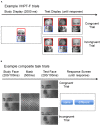Validation of the Vanderbilt Holistic Face Processing Test
- PMID: 27933014
- PMCID: PMC5120110
- DOI: 10.3389/fpsyg.2016.01837
Validation of the Vanderbilt Holistic Face Processing Test
Abstract
The Vanderbilt Holistic Face Processing Test (VHPT-F) is a new measure of holistic face processing with better psychometric properties relative to prior measures developed for group studies (Richler et al., 2014). In fields where psychologists study individual differences, validation studies are commonplace and the concurrent validity of a new measure is established by comparing it to an older measure with established validity. We follow this approach and test whether the VHPT-F measures the same construct as the composite task, which is group-based measure at the center of the large literature on holistic face processing. In Experiment 1, we found a significant correlation between holistic processing measured in the VHPT-F and the composite task. Although this correlation was small, it was comparable to the correlation between holistic processing measured in the composite task with the same faces, but different target parts (top or bottom), which represents a reasonable upper limit for correlations between the composite task and another measure of holistic processing. These results confirm the validity of the VHPT-F by demonstrating shared variance with another measure of holistic processing based on the same operational definition. These results were replicated in Experiment 2, but only when the demographic profile of our sample matched that of Experiment 1.
Keywords: VHPT; face recognition; holistic processing; individual differences; measurement.
Figures




References
-
- Aiken L. R. (1979). Psychological Testing and Assessment. Boston, MA: Allyn & Bacon.
-
- Calder A. J., Young A. W., Keane J., Dean M. (2000). Configural information in facial expression perception. J. Exp. Psychol. Hum. Percept. Perform. 26 527–551. - PubMed
-
- Cheung O. S., Richler J. J., Palmeri T. J., Gauthier I. (2008). Revisiting the role of spatial frequencies in the holistic processing of faces. J. Exp. Psychol. Hum. Percept. Perform. 34 1327–1336. - PubMed
Grants and funding
LinkOut - more resources
Full Text Sources
Other Literature Sources

